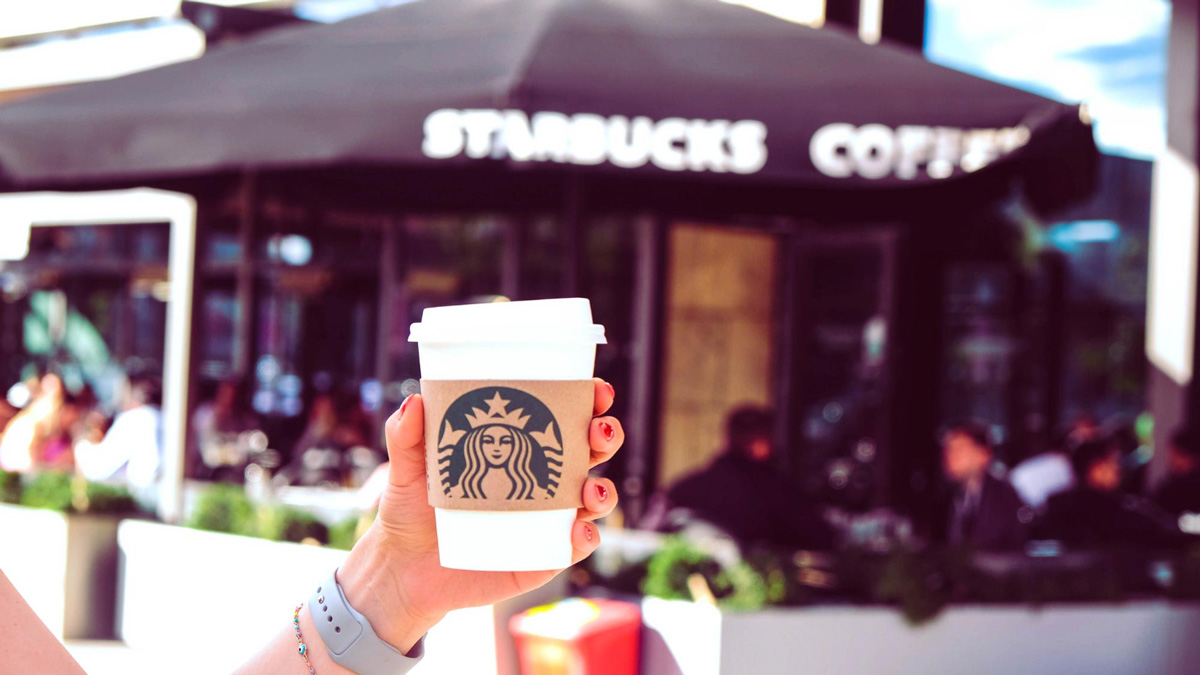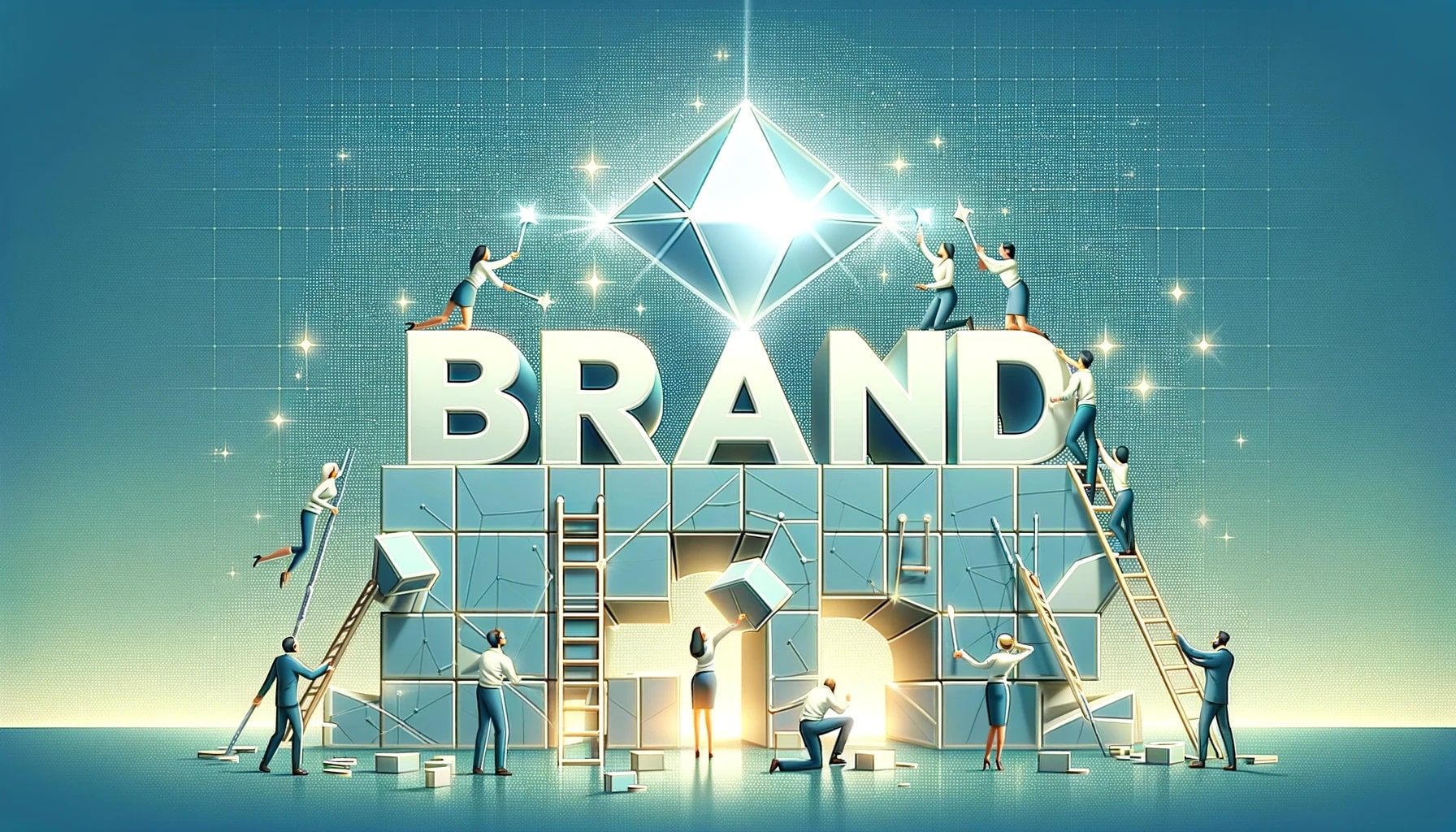
- A Concise Overview of Brand Definition
- What is Brand Equity? What Does it Mean?
- 6 Considerable Benefits of Brand Equity
- Comprehensive Guide on Building a Promising Brand Equity
- 5 Examples of Superb Brand Equity Among Industry Leaders
- How to Measure Brand Equity? What are Brand Equity Models?
- Embrace Brand Equity to Elevate Your Business
Effective branding increases the likelihood of business success. Brand equity is a critical concept closely related to branding, and it is about how people think and feel about your company.
This blog is about brand equity. We want to examine all aspects of this term to see how it influences the prosperity of a business, how to create brilliant brand equity through marketing activities, what its benefits are, and how to measure it.
But first of all, defining the term brand is crucial and unavoidable.
A Concise Overview of Brand Definition
Although many misunderstand the brand definition with the names and logos of businesses, it is much more than that!
The term “brand” is one of those words that many use, and they believe they grasp the meaning, but most people don’t understand the true sense.
Brand refers to the overall experience a business provides for its audience.
It is a unique mark that helps you determine something you love or dislike!
Think of Ferrari, for example! What comes into your mind? The yellow logo with a horse standing on its feet? Superb sports cars that grab everyone’s attention? Sense of Italy? Luxury mood? Or simply all of them?
Usually, the name Ferrari reminds people of all the above, resulting from Ferrari’s branding!
So that is the definition of “brand” in simple terms.
Now, it is time to answer the central question of this blog.
What is Brand Equity? What Does it Mean?
In the previous section, we understood that the brand is the people’s perception of a company’s existence, while brand equity refers to the brand’s extra value.
It is about the added value of the brand built over time. If you create a positive atmosphere around your business, you are likely to succeed in brand equity.
In this case, the brand name gives extra value to the products and services you are offering to your target audience.
To illustrate the meaning of this concept, let us consider an example.
Imagine you are in a store and want to buy a drink. There are two options with totally similar features and even appearance. One of them is Redbull, which is a well-known brand, and the other one is an unrecognized brand. Which one do you choose? The former is the answer.
The reason is that Red Bull has successfully built brand equity over several years, and it is safe to say this company is definitely triumphant in branding!
When people encounter Redbull’s cans or even see its logo on the wall, they get a good feeling about it, which is the magic of substantial brand equity.
It is worth noting that sound brand equity is crucial for business success, as it impacts customers’ decisions and marketing strategies and even influences potential partnerships with various firms.
Some main factors and elements play essential roles in creating good brand equity, which we will discuss here:
- Brand awareness: What percentage of your target audience knows your brand exists? How well-known is your company? Do they know everything about you and all the products and services you are offering? Higher brand awareness increases the chance of building solid brand equity.
- Brand perception: This element reflects people’s perceptions of the brand. More than being well-known and having a high brand awareness is required. Ensuring the target audience likes or loves your brand is essential to forming good brand equity. Brands lacking positive perception struggle to achieve this level of success.
- Brand quality: The quality of the products and services you sell impacts brand equity, too. Brand quality reflects how people perceive the grade of your products and services. Higher brand quality means a higher probability of creating sound brand equality.
- Brand loyalty: If you have a wealth of experience in the marketing world, turning regular customers into loyal ones is a fundamental matter. Brand loyalty reveals how successful you were in creating such a base. In other words, brand loyalty is the metric that shows the percentage of customers willing to repurchase from the brand and recommend it to others.
- Brand trust: In addition to all we have discussed up until this point, achieving strong brand equity requires gaining target audience trust. Do consumers fully trust your brand? The answer lies in the Brand trust element.
- Brand differentiation: You must have some advantage over your competitors to impress your business’s potential customers. It is about the value you offer that sets you apart from the competition, making it easier for the target audience to choose you over other market players.
Now, you know everything about brand equity and the elements that contribute to it. Let’s move ahead and get familiar with the benefits derived from the extra value your brand offers.
6 Considerable Benefits of Brand Equity

When brand development results in solid brand equity, it’s evident that this intangible brand asset brings numerous advantages that benefit the business.
We will explore these advantages in detail in this section of the blog:
Setting Higher Prices Is Possible
Assuming good brand equity has been built over time, the target audience now preserves the brand as a valuable business offering high-quality products and services. As a result, customers won’t hesitate to pay higher prices, which is a significant accomplishment.
The business can charge more than competitors because the target audience believes they are purchasing something special, and price becomes less of a factor in their decision-making process.
Increased prices translate to higher net profits, which is essential for any business’s success.
The Sales Numbers Will Increase
With a good brand strategy, you can expect increased sales. Established brands that evoke positive feelings and emotions among their target audience will be able to attract more paying customers who are willing to buy their services and products. This is the result of powerful brand equity.
Turning More Regular Customers into Loyal Customers
Famous brands with good reputations will likely establish a substantial loyal customer base. As we’ve previously discussed, achieving this milestone is crucial, and now you know it is one of the benefits of good brand equity.
Potential customers tend to support well-loved and popular brands and tell others about their high-quality products and services. They are eager to convey their feelings and emotions for the brand to others they know.
Gaining a Significant Competitive Advantage
No matter your industry, numerous brands offer products and services that are precisely similar to yours. First, you should gain a competitive advantage over your rivals to attract more customers, setting you apart from the competition and making your business shine bright in even the busiest markets.
As mentioned earlier, achieving strong brand equity is the key to making a positive, credible picture of your brand in the target audience’s mind. Therefore, it can help you be unique and separate from all other players in the same field.
Attracting Talents Becomes Much Easier
People would kill for a job in established brands. Hence, attracting capable talents in various fields is much easier for businesses that successfully create robust brand equity.
These days, finding qualified experts and convincing them to sign a job contract is more complex than ever. This advantage is among the most appealing benefits of building additional value for your brand.
Surviving Severe Crises Is Achievable
Sooner or later, crises will appear, and that is unpreventable! Although many companies suffer from these happenings, established, credible brands with a large base of loyal customers are more likely to survive and take less damage than other contenders.
Even if your business makes an unforgivable mistake, recovery is much easier than when a less-known brand makes the same error.
People will continue to blame companies with weaker brand equity and tend to absolve those brands they love and have positive feelings toward.
Now, you have enough information about the definition of brand equity and its benefits for businesses. The question is how to build influential brand equity.
Comprehensive Guide on Building a Promising Brand Equity
You can accomplish robust brand equity through effective brand marketing, making your business unique and desirable.
Here, we will examine some functional solutions to achieve this great goal.
Invest in Brand Identity
Before optimizing brand equity, the business must create a strong brand identity, including a proper name, logo, slogan, color palette, right messaging, visual identity, etc.
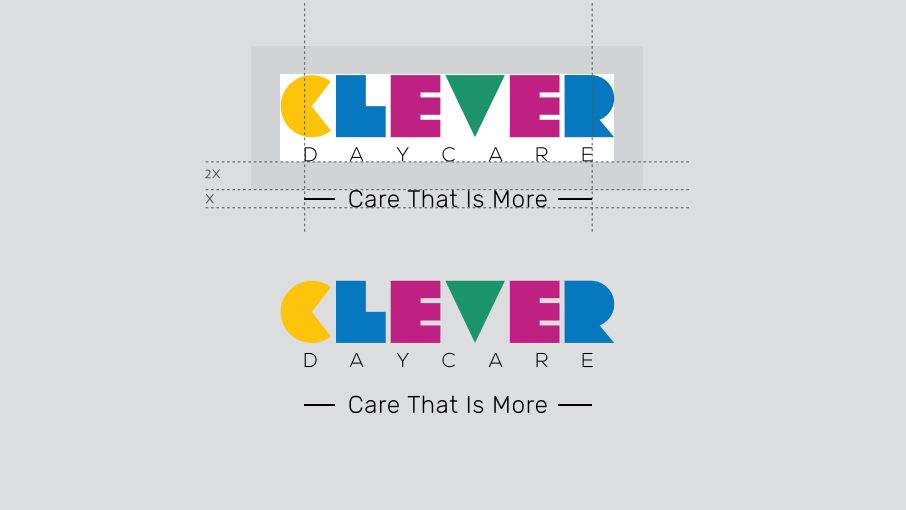
Keep in mind that it is essential to define your brand precisely, as this lays the foundation for establishing groundbreaking brand equity.
Answer the following questions, as they will help you to form a solid brand identity:
Which characteristics make your company distinctive?
What feelings do you plan to evoke in the target audience’s mind?
What image do you want to form in the potential customers’ minds?
The fundamentals for achieving outstanding brand equity are closely related to creating a solid brand identity.
Caring About Brand Consistency
After developing your brand identity most efficiently, you must take the necessary steps to maintain brand consistency across all platforms.
All touchpoints must adhere to your established brand guidelines wherever the target audience interacts with the brand.
Regardless of the platform you are creating content for and showing activity in, visual identity, tone, voice, slogan, name, etc., must completely align with the brand identity you defined beforehand.
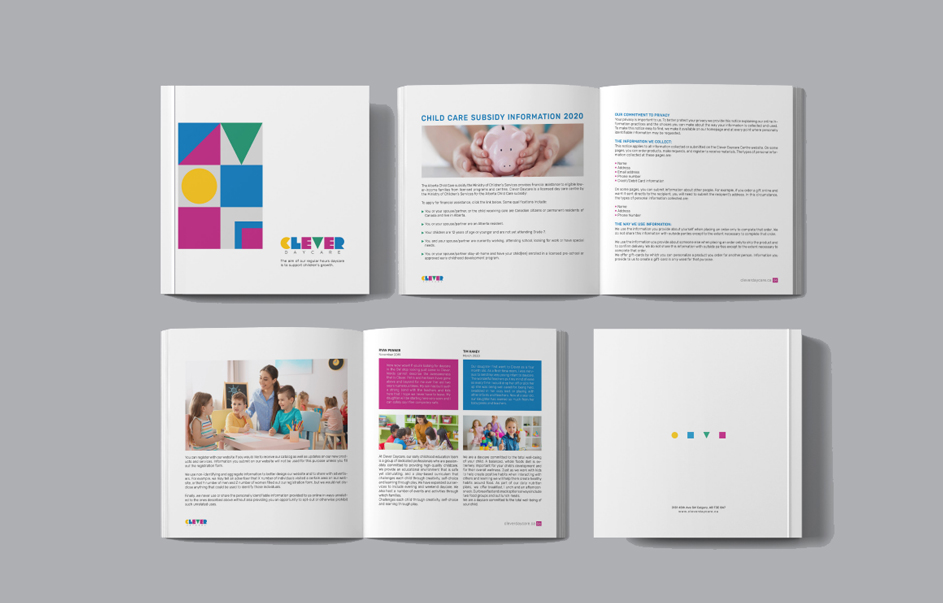
It is called brand consistency and is crucial to accomplishing your final goal: good brand equity!
Building Lasting Relationships With Customers
As mentioned, turning regular customers into loyal fans is a noteworthy benefit of enhancing brand equity.
Show your customers you care about them and value their concerns and requests. Answer their comments and engage with them on social media platforms. Train your support team well and teach them to be as helpful as possible.
Listen to their feedback, and if valid, implement the necessary changes to improve the overall user experience across your business.
Take approaches that result in increasing trust and expanding your loyal customer base.
Remember that good brand equity is highly dependent on what the target audience thinks and feels about your firm. That is why you should try your best to prove they mean a lot to you and do all you can to foster a great relationship.

Harnessing the Power of Word-of-Mouth Marketing
When your business is doing well, offering high-quality products and services, and delivering a great user experience, customers will likely introduce your brand to others! That is called word-of-mouth marketing, a practical marketing approach that many businesses prioritize.
Besides selling remarkable products and services, you can fuel the engine of this process by providing excellent customer support and engaging with the target audience wherever possible.
Creating Engaging and Attractive Content
Content is the bridge that connects businesses to their potential customers. The better you build this bridge, the more effectively you can attract the target audience in a way that makes them like and love your brand, leading to exemplary brand equity over time.
Research and gather needed information about your target audience’s concerns. Tailor content to their preferences and address their inquiries.
Invest in creating great stories for your brand, as storytelling is a type of content people genuinely love and can foster a strong relationship between both parties.
Also, it is suggested that you use diverse content formats, including text, video, audio, and images, to satisfy all of your potential customers.
In addition to these points and techniques, note that creating good brand equity takes time. Thus, patience is required, as you can’t achieve this goal quickly.
Identify what matters most to your target audience, prioritize those aspects, and provide value according to them.
Also, remember the importance of transparency and honesty. Losing credibility due to dishonesty undermines efforts to build significant brand equity.
Let’s discuss some examples and shed light on the concept.
5 Examples of Superb Brand Equity Among Industry Leaders
Here, we will explore five brands on the Fortune 500 list, examine their brand equity, and see why they are famous and recognizable names within their respective industries.
Walmart
Walmart was given the first position on the Fortune 500 list in 2024, and we are going to examine its brand equity here.

Their brand equity is complex and multifaceted. It encompasses both strengths and weaknesses. Therefore, people’s perception of Walmart heavily depends on demographics and individuals.
When people hear the name Walmart, they think of cheap products that they can easily access, as there are several branches of this brand all over the globe.
Walmart offers a wide range of products, leading many to perceive it as a one-stop shop for their needs.
However, lower prices raise concerns about the quality of products and also probably low labor wages. Additionally, considering its vast existence, several stores, and diverse product offerings, Walmart is accused of polluting the environment!
Therefore, low-income people looking for cheaper solutions visualize Walmart as a hero, providing their requirements with low prices. This company successfully creates excellent brand equity for this type of people, which is their target audience.
However, individuals prioritizing quality over price and environmental sustainability may view Walmart negatively. They think Walmart is a terrible brand that sells low-quality goods and pollutes the planet.
Amazon
Unlike Walmart, Amazon’s brand equity is exceptionally strong and growing to be better than ever.

This giant online retailer conveys the feeling of trust and convenience.
Their diverse products and fast and reliable delivery systems provide a great user experience for those seeking online goods.
Let us emphasize the variety of products and services Amazon sells. Amazon offers a wide range of products and services, from entertainment to tools.
These characteristics build an image of a complete brand in people’s minds.
Furthermore, they focus on satisfying their customers in the best way possible.
Thus, people worldwide know Amazon as a reliable, trustworthy, and affordable brand they can visit to buy everything at the best price.
Despite facing challenges such as criticism regarding its dominance in the online retailing industry, Amazon continues to build a good reputation and increase brand awareness, which results in remarkable brand equity alongside millions of loyal customers.
Apple
Apple is one of the companies with the most robust brand equity!

What comes to mind when you see an Apple product or hear the firm’s name? Innovation and highest tech products? So, the deceased Steve Jobs and his successors successfully formed an outstanding brand equity.
Apple consistently ranks among the top firms in the Fortune list. That is the fruit of consistent and excellent branding.
This brand is known as a premium utility maker, so its products are generally more expensive than similar products its rivals supply. But as we said earlier, they successfully created their desired brand equity.
Therefore, despite the high prices, people form lines in front of Apple Stores to be pioneers of each new product this giant tech company produces.
In addition to high prices, apple products are limited in customization. Though again, the feeling people get from Apple’s products overcomes all these restrictions and challenges.
Ford Motor
Ford Motor Company is similar to Walmart in that it has a complex and multifaceted brand equity. The perception of this brand varies according to demographics, individuals, and product lines.
When discussing Ford, many people associate the brand with the large trucks commonly used by farmers for everyday tasks. As the foundation of this company dates back more than 100 years, heritage and legacy are other unique characteristics of this brand.
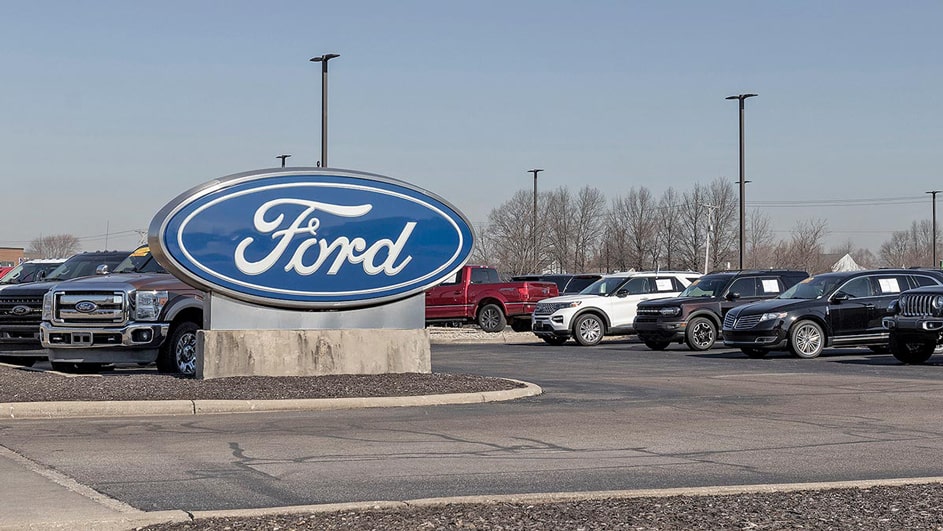
While the engineers in Ford’s factory try their best to add a touch of innovation and keep up with the fast-paced world of technology, Ford’s reputation as an innovative car manufacturer may be perceived differently by consumers.
It is one of the challenges they face in terms of brand equity. Let’s say they have a problem in creating a consistent brand.
Although this company builds sports and passenger cars, most people know the brand with its trucks.
Additionally, the competition with some strong opponents, such as Toyota and GM, puts pressure on Ford Motor to maintain its market share and continue to be the final choice of many consumers all around the globe.
Microsoft
With its famous founder, Bill Gates, Microsoft has been one of the world’s biggest tech companies for decades.
Microsoft is doing well in brand equity, as people perceive this brand as a pioneer in innovation and leadership in the tech industry.
Their wide range of products and services satisfy many potential customers.

Furthermore, Microsoft invests a lot in customer support and tries to foster a great relationship with its customers, which, as said above, is crucial to developing outstanding brand equity.
There are challenges, too. Microsoft has powerful rivals in every field, such as Sony’s gaming console, Xbox’s direct competitor, and Linux, the most prominent Windows opponent.
Their weaknesses against these big names slightly affect their reputation and raise criticism towards them. Overall, Microsoft’s brand equity remains strong despite these challenges.
Please note that brand equity is a concept that continues to evolve, and each brand’s performance in terms of providing extra value and making a good picture in the target audience’s mind heavily depends on their ability to encounter changes and adapt to customers’ new preferences.
Brands use various models to measure their brand equity, which we will debate in the following section.
How to Measure Brand Equity? What are Brand Equity Models?
Leading up to this point, we have defined brand equity, explored its benefits, discussed the importance of brand equity in marketing, and cited some examples of well-known brands and their performance in offering added value to their brand.
The question here is: How do we measure this metric? How do you know you perform well or poorly in creating positive brand equity?
The answer lies in brand equity models! These models are like maps that help you to understand how customers think and feel about your business.
Thanks to them, you can determine the value of your brand in your target audience’s mind.
Let’s learn about these models and how to measure brand equity for different businesses.
Keller Brand Equity Model
As discussed above, brand equity consists of various elements, and forming a positive relationship with customers is crucial to this achievement.
The Keller model emphasizes creating such relationships and turning more regular clients into loyal ones. Therefore, experts call it a customer-based brand equity model. It highlights the importance of satisfying buyers to build firm brand equity.
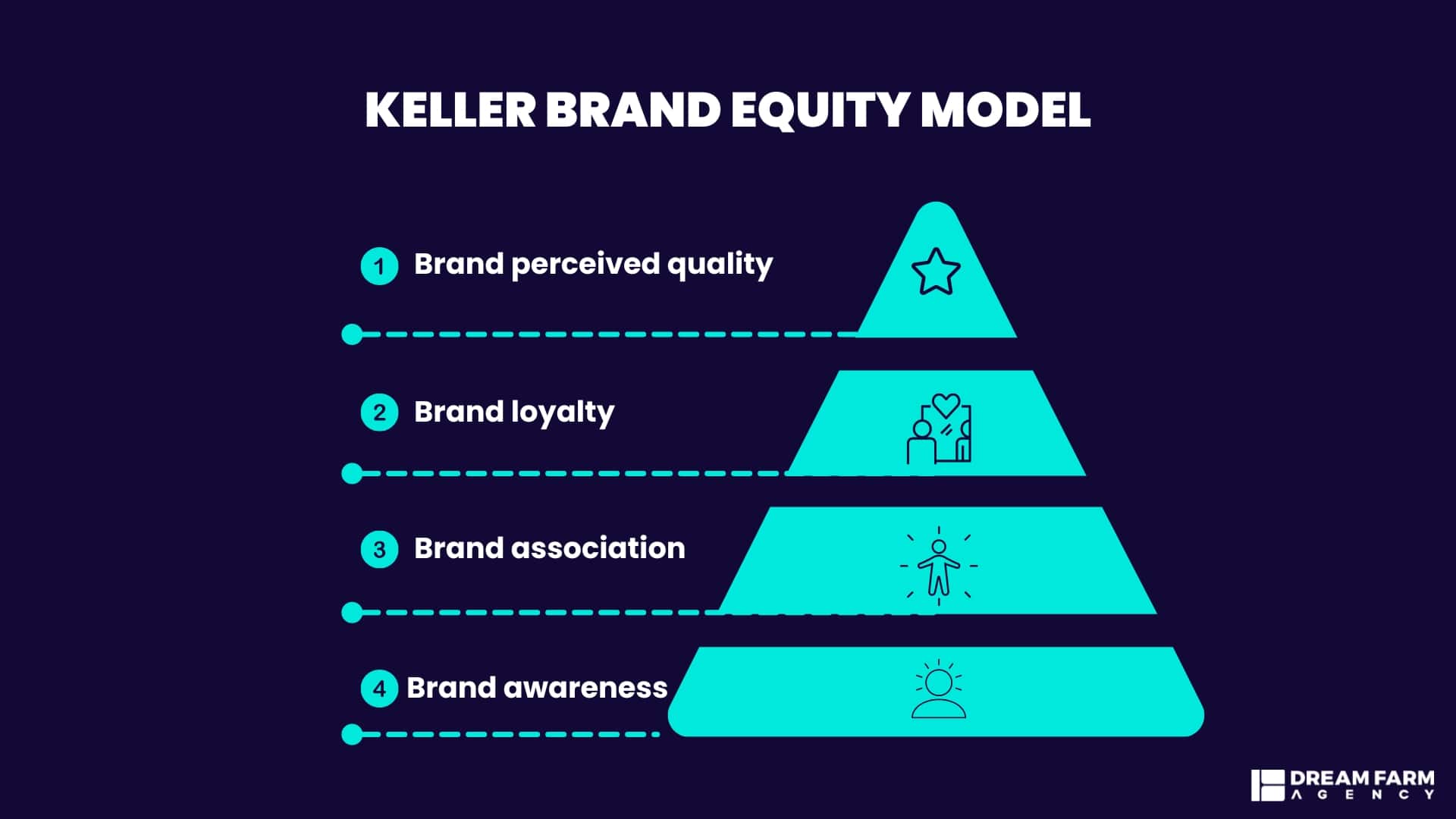
This model proposes a pyramid with four stages, which are:
- Brand awareness: How well-known is the brand?
- Brand association: What emotions, feelings, and thoughts the brand brings to the minds of the target audience?
- Brand loyalty: How many loyal customers does the brand have? Was it successfully creating a vast group of ambassadors that talk about the brand and defend it like their favorite sports club?
- Brand perceived quality: Do people know the business as high-quality, or do they perceive it as an imperfect brand that sells worthless products and services?
Moving forward with this model, you should gauge these four metrics and find out how the business is performing in terms of providing extra weight and enhancing brand equity.
Aaker Brand Equity Model
Like The Keller model, the Aaker model is a customer-based brand equity measurement system. But with one significant difference.
As discussed in the previous section, the Keller model suggests gauging four elements, while the Aaker model says five elements must be considered and measured.
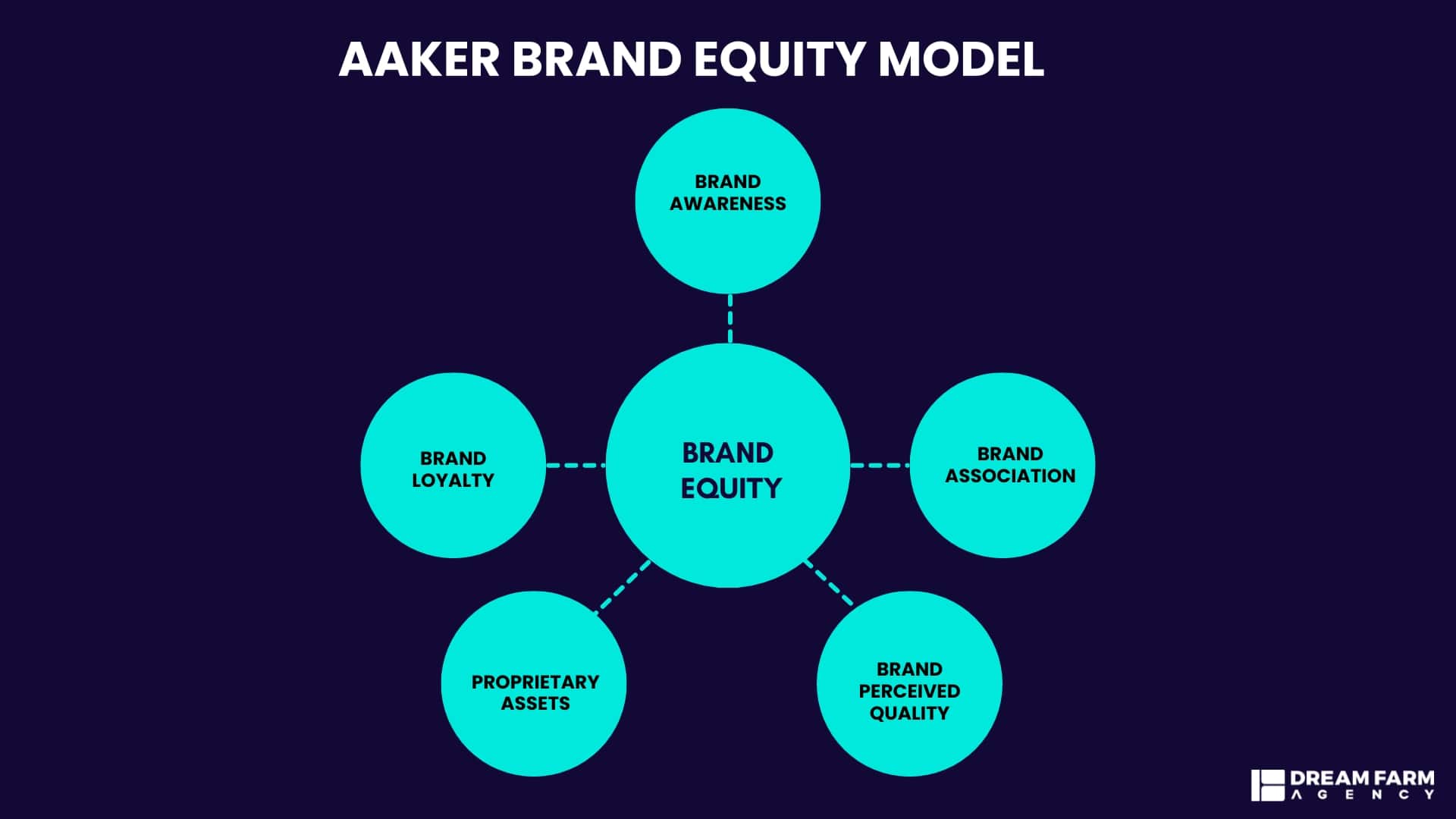
In addition to those four elements, this model emphasizes the importance of brand assets.
Brand assets encompass both tangible acquisitions, such as trademarks and patents, as well as intangible elements, like solid customer relationships and skilled personnel within your team.
Therefore, in addition to the perception of the brand that people have in mind, the Aaker model underlines the importance of the brand’s legal and intangible assets.
Brand Asset Valuator (BAV)
Unlike the two previous models, the BAV model assesses brand equity across various aspects, not just the brand’s perception in customers’ minds.
Young & Rubicam, the American marketing and communication company, developed this model, and they use that to measure brand equity across ten dimensions through four key areas:
- Differentiation: Assessing elements that set the brand apart from its competitors.
- Relevance: Determining a brand’s ability to address the target audience’s needs and requirements by producing relevant goods and services.
- Esteem: Considering elements that generate respect, admiration, and trust.
- Knowledge: Assessing if the target audience knows everything about the values that the brand proposes.
Comparing Keller and Aaker models, the Brand Asset Valuator, aka BAV, is much more comprehensive and measures many more aspects of each brand to determine whether the business successfully created potent brand equity.
There are more brand equity models, but these three are the most famous ones and the ones that so many firms utilize globally to check their performance regarding providing extra value for their brand.
Consider your needs and preferences to choose the suitable model for gauging brand equity.
So, one more time, let’s take a look at each model’s suitability:
- Keller and Aaker model: Suitable if you want to gather information about general customer perceptions and turn regular customers into loyal fans.
- Brand asset valuator (BAV): Suitable if you need a comprehensive, in-depth analysis of your brand performance across various areas.
We discussed almost everything about brand equity, and now, it is time to wrap up the blog.
Embrace Brand Equity to Elevate Your Business
Good brand equity is an essential aspect of the branding process that businesses should plan to achieve in the long term.
As defined in this blog, the term refers to people’s perception of your business. The better it is, the more successfully your business will operate. You can benefit from being a well-known brand with a good reputation.
Establishing a solid foundation for your business begins with effective branding, which includes brand design, creating a brand mascot total solution, planning a sound branding and marketing strategy, creating creative content, etc.
At Dream Farm agency, we can help you achieve this goal and build outstanding brand equity that differentiates you from all your rivals and sets you apart in competitive markets.
Nikan
